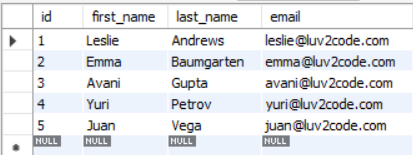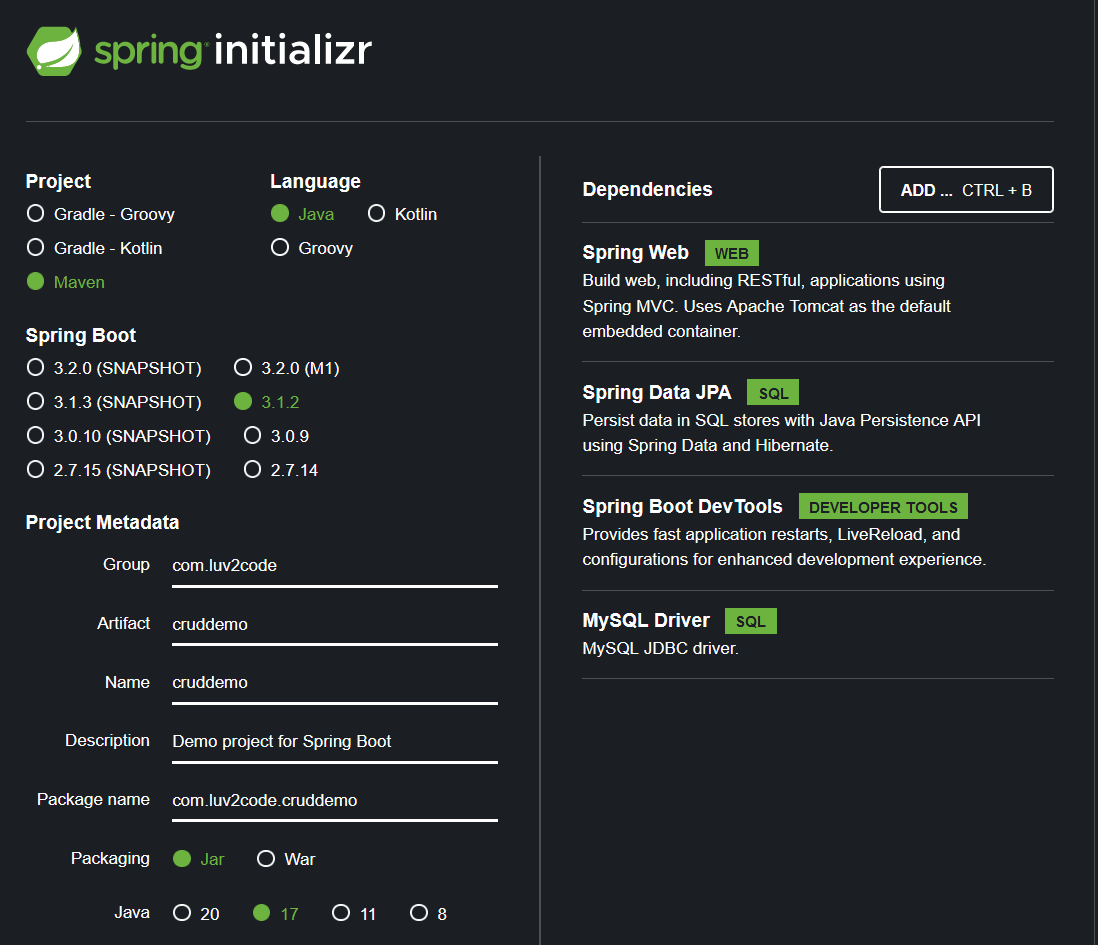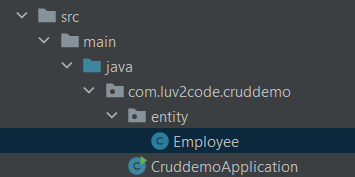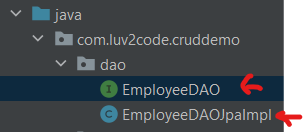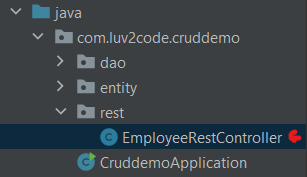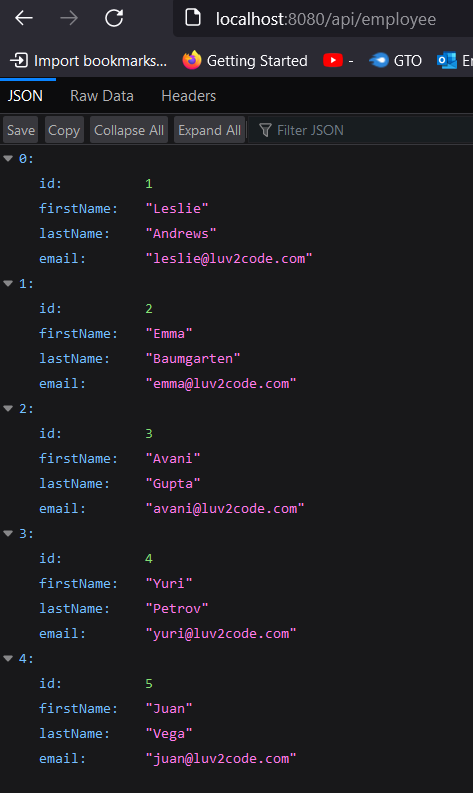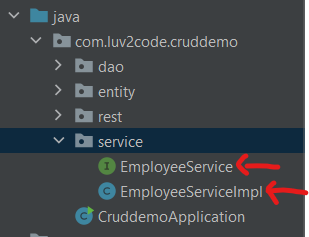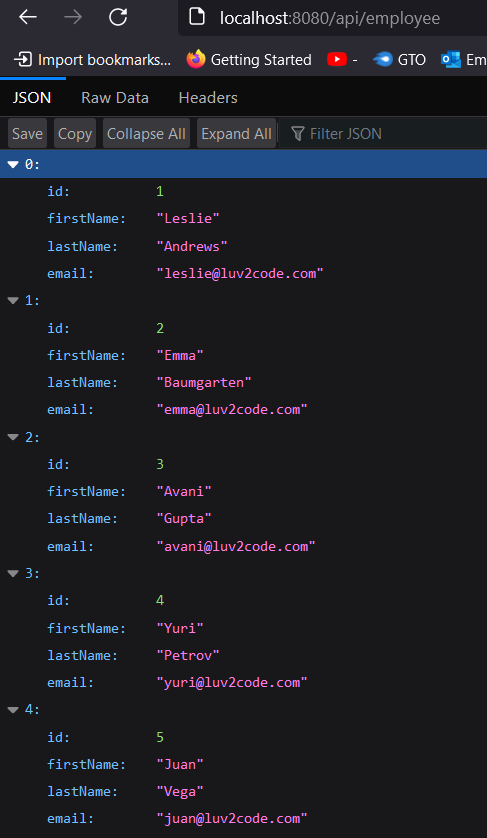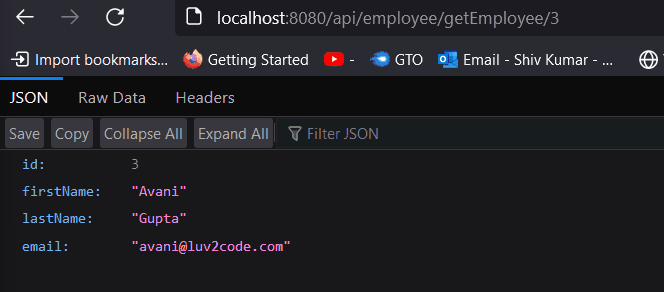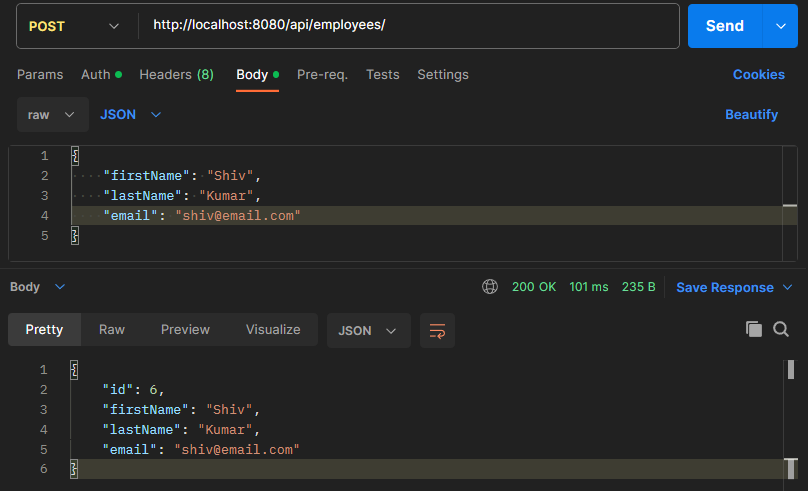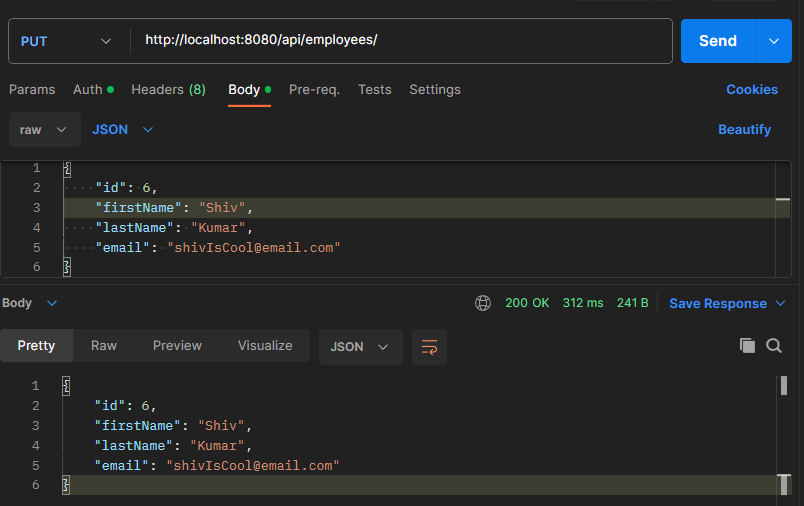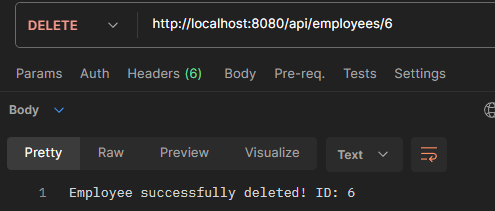- I started this project on 23/07/2023 while working through Chad Darby's Spring and Hibernate Course
- You can find my main repo for this course here
-
For this project, I needed to create a RESTful API which connects to a database. Here are the requirements:
-
We need to create a REST API for the Employee directory
-
The API must be able to handle the following HTTP methods:
| HTTP Method | CRUD Action |
|---|---|
POST /api/employees |
Create a new employee |
GET /api/employees |
Retrieve employees |
GET /api/employees/{employeeId} |
Retrieve an employee via ID |
PUT /api/employees/{employeeId} |
Update and employee via ID |
- Set up database dev environment
- Create Spring Boot project using Spring Initialzr
- Get list of employees
- Get single employee via ID
- Create a new employee
- Update an existing employee
- Delete an existoing employee
- I have been provided sample data from employee-directory.sql
- I install MySQL + Workbench, I connect to my Local Instance and run the SQL script:
CREATE DATABASE IF NOT EXISTS `employee_directory`;
USE `employee_directory`;
--
-- Table structure for table `employee`
--
DROP TABLE IF EXISTS `employee`;
CREATE TABLE `employee` (
`id` int NOT NULL AUTO_INCREMENT,
`first_name` varchar(45) DEFAULT NULL,
`last_name` varchar(45) DEFAULT NULL,
`email` varchar(45) DEFAULT NULL,
PRIMARY KEY (`id`)
) ENGINE=InnoDB AUTO_INCREMENT=1 DEFAULT CHARSET=latin1;
--
-- Data for table `employee`
--
INSERT INTO `employee` VALUES
(1,'Leslie','Andrews','leslie@luv2code.com'),
(2,'Emma','Baumgarten','emma@luv2code.com'),
(3,'Avani','Gupta','avani@luv2code.com'),
(4,'Yuri','Petrov','yuri@luv2code.com'),
(5,'Juan','Vega','juan@luv2code.com');- I select the top row of the employee table:
- I use Spring Initialzr with the following config:
-
I unzip the
cruddemofolder and place it here -
I open up the pom.xml in IntelliJ
- In order for Spring Boot Dev Tools to work properly I change the following settings:
- Build, Execution, Deployment > Compiler > Tick Build Project Automatically
- Advanced Settings > Tick Allow auto-make to start even if developed application is currently running
- I update the database configuration in application.properties:
# JDBC properties
spring.datasource.url=jdbc:mysql://localhost:3306/employee_directory
spring.datasource.username=root
spring.datasource.password=root- I create my
Employeeentity class in a new package calledentity:
- I define the class as:
@Entity
@Table(name="employee")
public class Employee {
@Id
@Column(name="id")
@GeneratedValue(strategy = GenerationType.IDENTITY)
private int id;
@Column(name="first_name")
private String firstName;
@Column(name="last_name")
private String lastName;
@Column(name="email")
private String email;
public Employee() {}
public Employee(String firstName, String lastName, String email){
this.firstName = firstName; this.lastName=lastName; this.email=email;
}
// getters and setters and toString()
}- I create an interface and implementation in a new
daopackage:
- The interface is defined as:
public interface EmployeeDAO {
List<Employee> findAll();
}- The implementation is defined as:
@Repository
public class EmployeeDAOJpaImpl {
private EntityManager entityManager;
@Autowired
public EmployeeDAOJpaImpl(EntityManager entityManager) {
this.entityManager = entityManager;
}
@Override
public List<Employeee> findAll() {
TypedQuery<Employee> query = entityManager.createQuery("FROM Employee", Employee.class);
List<Employee> list = query.getResultList();
return list;
}
}- I then create my REST controller in a new
restpackage:
- We do a quick and dirty implementation where we inject the DAO directly into the controller:
@RestController
@RequestMapping("api")
public class EmployeeRestController {
private EmployeeDAO employeeDAO;
public EmployeeRestController(EmployeeDAO employeeDAO) {
this.employeeDAO = employeeDAO;
}
@GetMapping("employee")
public List<Employee> findAll() {
return employeeDAO.findAll();
}
}- I run the application and realise I made the following typos:
- I missed the
@Idannotation for the Id field on Employee - In the query, I typed:
entityManager.createQuery("FROM employee", Employee.class);. I thought this was using the table name but its actually referencing the class!
- I run the application after fixing the above issues! I get the following result in my browser:
-
We shall create a Service which will interact with the
EmployeeDAO. A service layer allows us to create custom business logic and integrate data from multiple data sources. -
This is an implementation of the Service Facade design pattern - an object serves as a front-facing interface which masks more complex code. This improves readability and useability and provides more loosely coupled code!
-
We will use
@Serviceannotation and spring will automatically register the service implementation thanks to component scanning!
- I create a new
servicepackage for myEmployeeServiceinterface:
- The interface is defines as:
public interface EmployeeService {
List<Employee> findAll();
}- I implemented this interface using
EmployeeServiceImpldefined as:
@Service
public class EmployeeServiceImpl {
private EmployeeDAO employeeDAO;
public EmployeeServiceImpl(EmployeeDAO employeeDAO) {
this.employeeDAO = employeeDAO;
}
@Override
public List<Employee> findAll() {
employeeDAO.findAll();
}
}- I update the
EmployeeRestControllerto use the above service:
@RestController
@RequestMapping("api")
public class EmployeeRestController {
private EmployeeService employeeService; // CHANGED FROM EmployeeDAO
public EmployeeRestController(EmployeeService employeeService) {
this.employeeService = employeeService;
}
@GetMapping("employee")
public List<Employee> findAll() {
return employeeService.findAll();
}
}- I run my Spring application and it all works:
- It's best practice to apply transactional boundaried at the serive layer and remove it from the DAO layer (if they exist)
- I update the
EmployeeDAOinterface to include the following methods:
public interface EmployeeDAO {
List<Employee> findAll();
Employee findById(int id);
Employee save(Employee employee);
void deleteById(int id);
}- I override the unimplemented methods in
EmployeeDAOJpaImpl:
@Repository
public class EmployeeDAOJpaImpl implements EmployeeDAO {
private EntityManager entityManager;
public EmployeeDAOJpaImpl(EntityManager entityManager){
this.entityManager = entityManager;
}
public List<Employee> findAll() {
TypedQuery<Employee> query = entityManager.createQuery("FROM Employee", Employee.class);
List<Employee> list = query.getResultList();
return list;
}
public Employee findById(int id) {
TypedQuery<Employee> employee = entityManager.createQuery("From Employee WHERE id='" + id + "'", Employee.class);
return employee.getSingleResult();
}
public Employee save(Employee employee) {
Employee dbEmployee = entityManager.merge(employee); // saves or updates depending on id
return dbEmployee;
}
public void deleteById(int id) {
Employee employee = entityManager.find(Employee.class, id);
entityManager.remove(employee);
}
}- Note the
save()method will only insert the employee into the DB if the ID is not 0! Otherwise it will just update the employee!
- I update the
EmployeeServiceinterface:
public interface EmployeeService {
List<Employee> findAll();
Employee findById(int id);
Employee save(Employee employee);
void deleteById(int id);
}- I update the
EmployeeServiceImplto implement the unimplemented methods and delegate the calls toemployeeDAO
@Service
public class EmployeeServiceImpl implements EmployeeService {
private EmployeeDAO employeeDAO;
public EmployeeServiceImpl(EmployeeDAO employeeDAO) {
this.employeeDAO = employeeDAO;
}
public List<Employee> findAll() {
return employeeDAO.findAll();
}
public Employee findById(int id) { // NEW METHOD
return employeeDAO.findById(id);
}
@Transactional
public Employee save(Employee employee) { // NEW METHOD
return employeeDAO.save(employee);
}
@Transactional
public void deleteById(int id) { // NEW METHOD
employeeDAO.deleteById(id);
}
}- I apply
@Transactionalto all the methods which will modify the db in anyway!
-
I create a new mapping in my REST controller which will retrieve a single employee using the employeeID:
-
I create a new method in the
EmployeeRestController:
@GetMapping("getEmployee/{employeeId}")
public Employee getEmployeeId(@PathVariable int employeeId) {
Employee employee = employeeService.findById(employeeId);
if (employee == null) {
throw new RuntimeException("Employee was not found");
}
return employee;
}-
I check if this endpoint is working! I get an obscure message and realise my implementation of
findById()is incorrect in myEmployeeDEOJpaImplclass! -
I fix the method implementation:
@Override
public Employee findById(int id) {
TypedQuery<Employee> employee = entityManager.createQuery("From Employee WHERE id="+id, Employee.class);
return employee.getSingleResult();
}- Now I rerun my application and everything is working as intended:
- I create a new mapping in my controller which is a POST method to create and save a new employee:
@PostMapping("/employees")
public Employee saveEmployee(@RequestBody Employee employee) {
employee.setId(0); // just in case user supplied uneeded parameter
Employee savedEmployee = employeeService.save(employee);
return savedEmployee;
}- I make a POST request in postman:
-
A response was recieved so the post method works!!!
-
I verify that the new employee appears in the database:
- I will create a new endpoint in my controller which will allow the user to update an existing employee and return the updated employee back!
@PutMapping("/employees/")
public Employee updateEmployee(@RequestBody Employee employee) {
// if employee exists then update, else save employee
Employee updatedEmployee = employeeService.save(employee);
return updatedEmployee;
}- I verify that this new endpoint is working:
- I create a new endpoint which lets the user delete an employee via ID:
@DeleteMapping("/employees/{employeeId}")
public String deleteEmployee(@PathVariable int employeeId) {
if (employeeService.findById(employeeId) == null)
throw new RuntimeException("Employee ID not found: "+employeeId);
employeeService.deleteById(employeeId);
return "Employee successfully deleted! ID: "+employeeId;
}- I verify I can delete an employee:
-
PROBLEM: I want to create a new entity but I don't want to write a bunch of boiler-plate code.
-
SOLUTION: Spring Data JPA provides CRUD elements just by supplying the entity and the primary key!
-
Spring Data JPA provides a
JpaRepositoryinterface which will provide the following methods:findAll(),findById(),save(),deleteById()and others!
-
I refresh my SQL database by running the script from the sample data again!
-
I create a copy of the
cruddemofolder and rename it tocruddemo_v2 -
I delete
EmployeeDAOandEmployeeDAOJpaImplfrom thedaopackage! -
I define a new interface -
EmployeeRepository:
public interface EmployeeRepository extends JpaRepository<Employee, Integer> {
}- I then refactor
EmployeeServiceImplto use EmployeeRepository:
@Service
public class EmployeeServiceImpl implements EmployeeService {
private EmployeeRepository employeeRepository;
public EmployeeServiceImpl(EmployeeRepository employeeRepository) {
this.employeeRepository = employeeRepository;
}
public List<Employee> findAll() {
return employeeRepository.findAll();
}
public Employee findById(int id) {
return employeeRepository.findById(id).orElseThrow(()->new RuntimeException("Did not find employee"));
}
// @Transactional - no longer needed
public Employee save(Employee employee) {
return employeeRepository.save(employee);
}
// @Transactional - no longer needed
public void deleteById(int id) {
employeeRepository.deleteById(id);
}
}- I run the application, and all the CRUD operations are behaving normally!
-
Spring Data REST leverages the existing
JpaRepositorysubclasses and expose the endpoints for free! -
Spring Data REST will create the endpoints using the entity name, making it lowercase and making it pluralised.
Employee->employees -
All we need to do this is update the Maven POM file with the following dependency:
<dependency>
<groupId>org.springframework.boot</groupId>
<artifactId>spring-boot-starter-data-rest</artifactId>
</dependency>-
Spring Data REST endpointsd are HATEOAS compilant, i.e. the meta-data of the responses will be compiant
-
E.g. the REST response from
GET /employee/3:
{
"firstName": "Shiv",
"lastName": "Kumar",
"email": "shiv@email.com",
"_links": {
"self": {
"href": "http://localhost:8080/employees/3"
},
"employee": {
"href": "http://localhost:8080/employees/3"
}
}
}- If the REST response is a collection, then the meta data will contain page size, total elements, pages etc. E.g.:
{
"_embedded": {
"employees": [
{
"firstName": "Shiv",
...
},
...
]
},
"page": {
"size": 20,
"totalElements": 5,
"totalPages": 1,
"number": 0
}
}-
I refresh my database and make a clone of
crumdemo_v2calledcrumdemo_v3 -
I update the
pom.xmlto include the following dependency:
<dependency>
<groupId>org.springframework.boot</groupId>
<artifactId>spring-boot-starter-data-rest</artifactId>
</dependency>-
I'll delete my
serviceandrestpackages of my project! -
I run the application and I am able to retrieve the employees information by going to
localhost:8080/employees -
I can update the endpoint locations by specifying some properties in
application.properties:
# Spring Data REST properties
spring.data.rest.base-path=/magic-api- Now we have endpoints like
http://localhost:8080/magic-api/employees
-
Spring Data REST does not handle complex pluralised names for entities. I.e
Goosebecomesgooses -
We have a solution to this issue. E.g. suppose we wanted our endpoints to contain
membersand notemployees. We can use the@RespositoryRestResource:
@RepositoryRestResource(path="members")
public interface EmployeeRespository extends JpaRepository<Employee, Integer> {
}-
By default, Spring REST will return 20 elements per page. The pages can be accessed via the URL (e.g. page 1 is
http://localhost:8080/magic-api/employees?page=0) -
We can override the number of elements, and page number limits via the following properties:
| Name | Description |
|---|---|
spring.data.rest.base-path |
Base path used to expose repository resources |
spring.data.rest.default-page-size |
Default size of pages` |
spring.data.rest.max-page-size |
Maximum size of pages |
-
We can sort by the property names of the entity by specifying a paramater in the URL.
-
E.g. to sort the json by last name, descending we would use:
http://localhost:8080/magic-api/employees?sort=lastName,desc- If we wanted to sory by last name, then first name:
http://localhost:8080/magic-api/employees?sort=lastName,firstName,asc